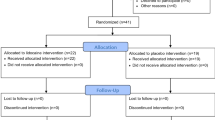Abstract
Our aim was to quantify the analgesic efficiency of the patient-controlled analgesia technique (PCA), using ketorolac, in children aged 6–14 undergoing a surgical intervention. We carried out a double-blind test with two randomly selected groups: the PCA group comprising patients submitted to intravenous PCA, with “bolus on demand” and the Standard group, with conventional analgesia dispensed with ketorolac I.V. (0.5 mg/kg/6 hours). Evaluation of pain experienced was performed using the Hannallah behavioural scale and quantification of the summing of pain intensity. Analgesic efficiency was determined by the pain intensity difference (PID) score. Evaluation of pain experienced during hour 1 reveals a marked reduction with time for each group; no inter-group differences were found. At hour 6 there were neither intra-group nor inter-group differences. The accumulated pain score revealed a significant reduction in hour 6, with no differences between the two groups. Evaluation of the analgesic effect revealed no differences, either intra-group or intergroup, during the experimental period. The sum of the PIDs revealed significant differences in the standard group between the values for hours 1 and 6. Under the experimental conditions described, both techniques were equally effective for pain treatment, but the efficiency was higher for the PCA group.
Resumen
Se cuantifica la eficacia analgésica de la técnica de analgesia controlada por el paciente (ACP), utilizando ketorolaco, en niños de 6 a 14 años intervenidos quirúrgicamente. Se efectúa un ensayo doble ciego con dos grupos aleatorios: grupo ACP de pacientes sometidos a ACP intravenosa de “bolos a demanda” y grupo pautado de analgesia convencional pautada con ketorolaco I.V.(0,5 mg/kg/6 horas). La evaluación del dolor se realiza mediante la escala conductual de Hannallah y la cuantificación del sumatorio de la intensidad del dolor. La eficacia analgésica se determina mediante los valores de diferencia en la intensidad del dolor (PID). La valoración del dolor durante la hora 1 muestra una clara disminución con el tiempo dentro de cada grupo, no existiendo diferencias intergrupales. A la hora 6 no hay diferencias ni intra ni intergrupales. La suma acumulativa de la puntuación del dolor presenta una disminución significativa en la hora 6, no apareciendo diferencias entre ambos grupos. La valoración del efecto analgésico no presenta diferencias ni intra ni intergrupales en el periodo experimental considerado. La sumatoria de los PID muestra diferencias significativas en el grupo pautado entre los valores de la hora 0 y 6. En las condiciones experimentales descritas, ambas técnicas son igualmente eficaces para el tratamiento del dolor, pero la eficiencia es mayor en el grupo ACP.
Similar content being viewed by others
References
Berde, C. B., Lehn, B. M., Yee, J. D., Sethna, N. F. G. and Russo, D. (1991): J. Pediatr., 118, 460–466.
Brown, R. E. and Broadman, L. M. (1987): Anesth. Analg., 66, S22.
Dodd, E., and Rauck, R. L. (1988): Anesthesiology, 69, A372.
Dundee, J. W. (1980): Br. J. Clin. Pharmacol., 10, 329S-334S.
Eland, J. M. and Anderson, J. E. (1977): In “Pain: a sourcebook for nurses and other health professionals” (A. Acox, ed.). Little, Brown & Co., Boston. pp. 453–473.
Fischberg, B. L., Mead, D. S. and Ritter, H. T. M. (1991): Hospital Pharmacy, 26, 412–423.
Florez, J., Armijo, J. A. and Mediavilla, A. (1987): Farmacología Humana. Ediciones Universidad de Navarra, Pamplona.
Hannallah, R. S., Broadman, L. M., Belman, A. B., Abramowitz, M. D. and Epstein, B. S. (1987): Anesthesiology, 66, 832–834.
Huskisson, E. C. (1974): Lancet, 2, 1127–1131.
Mather, L. and Mackie, J. (1983): Pain, 15, 271–282.
Mather, L. E. and Owen, H. (1988): Anaesth. Intensive Care, 16, 427–447.
Maunuksela, E. L., Kokki, H. and Bullingham, R. E. S. (1992): Clin. Pharmacol. Ter., 52, 436–443.
Means, L. J., Allen, H. M., Lookabill, S. J. and Krishna, G. (1989): Anaethesiology, 69, A772.
Palacio, M. A., Castejón, J., Gálvez, R., García-Sanchez, M. J., Vázquez-Alonso, E., Perán, F. and Moreno-Prieto, M. (1997): Rev. Soc. Esp. Dolor, Supl 1, 12–17.
Palacio, M. A., Castejón, J., Palop, E., García-Sánchez, M. J., Sánchez López-Tello, C. and Moreno-Prieto, M. (1997): Cir. Pediatr., 10, 93–95.
Sechzer, P. H. (1967): Rev. Argen. Angiology, 1, 9–12.
Sechzer, P. H. (1990): Anesthesiology, 72, 726–735.
Author information
Authors and Affiliations
Rights and permissions
About this article
Cite this article
Moreno, M., Castejón, F.J. & Palacio, M.A. Patient-controlled and analgesia with ketorolac in pediatric surgery. J. Physiol. Biochem. 56, 209–215 (2000). https://doi.org/10.1007/BF03179788
Received:
Issue Date:
DOI: https://doi.org/10.1007/BF03179788




